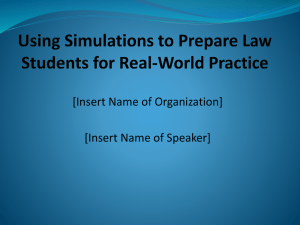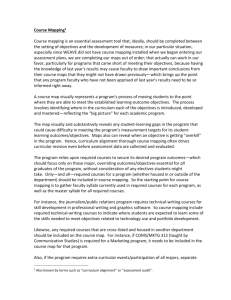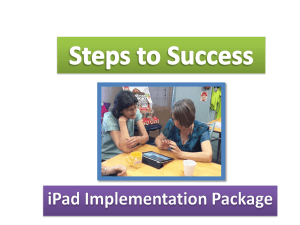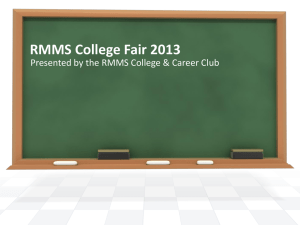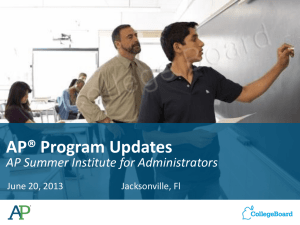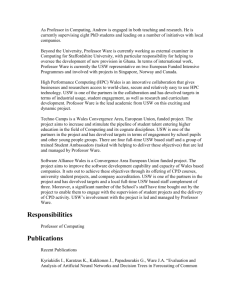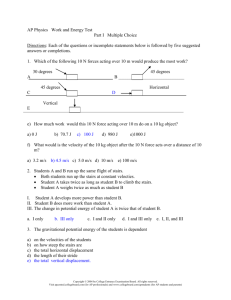AP Physics 1 & 2 Launching AP Physics 1 & 2 AP PHYSICS 1 and 2
advertisement
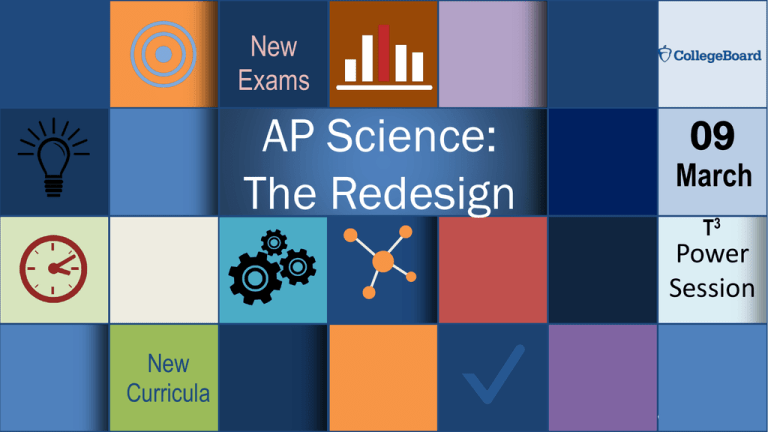
New Exams AP Science: The Redesign 09 March T3 Power Session New Curricula Two Important Numbers 2,400,000 90% Georgetown STEM report 5 The Jobs of the Future are Already Here “Technology today can do in five minutes a decoding task that would have taken a year to complete a decade ago”-Eric Lander, Founder, The Broad Institute “The future is already here –it's just not very evenly distributed.”William Gibson Robotic Hand Google Car 01 02 Hatsune Miku 04 Teenage BioTech Company 05 03 IBM WATSON “A quantum computer of just 150 QuBits would have the power of all of today’s supercomputers”-Alan Aspuru-Guzik, Harvard University..we are currently at 128 bits We Need to Upskill Supply Line is Leaking How Do We Maximize Output? We Must Update the STEM Curricula, Instruction, and Assessments • From this…. …to this STEM Ed: Goal • Develop and supply the applicants needed for the demand of STEM-capable workers NRC (2011) Successful K-12 STEM Education Addressing STEM Ed Goals through the AP Science Redesign Evidence Centered Design, Assessment, & Science Practices • Evidence Centered Design ensures consistent measurement of the learning objectives across forms • Course learning objectives (claims) provide transparency pertaining to the assessment • New item types emerge from application of the science practices within real world contexts Challenges with Implementation • Lack of teacher “comfort” with the paradigm shift • Lack of teacher familiarity with instructional strategies leading to evidence of students applying the science practices • Lack of existing assessment items aligned with the redesigned course Lessons Learned and Changes Made • Teachers need more time to make a paradigm shift • Teachers need to feel ready to implement the changes • Teachers need to feel confident with the amount and alignment of teacher support materials Provide effective messaging and professional development earlier. Engage and empower teachers to evaluate, reflect , and redesign Align textbook and test prep publishers with the changes earlier. AP Biology Course and Exam Changes Content and Depth New approach: Essential content + skills + inquiry New structure: 4 Big Ideas, 17 Enduring Understandings New transparency into exam: Learning Objectives, Formula List, Usage of Calculators Breadth reduction in four ways: Factual recall reduced for exam Teacher choice of illustrative examples Explicit exclusion statements in Curriculum Framework Specific content reductions Probe ware and Software Technology in AP Biology Tablets & iPads Virtual Labs & Simulations TINspire for ease of data collection and manipulation Smart Phones AP Chemistry Course and Exam Changes AP Chemistry Course and Exam Changes New approach: Essential content + skills + inquiry New structure: 6 Big Ideas, 117 Learning Objectives New formula List, change in usage of calculators on exam Breadth reduction in three ways: Factual recall reduced for exam Explicit exclusion statements in Curriculum Framework Specific content reductions Organization of the New AP Chemistry Section 1: Exam • • • • • 60 Multiple Choice (with question sets) 90 minutes 50% of exam weight May use Periodic Chart and Formula Sheet May NOT use calculator Section 2: • 7 Free Response questions – 3 long and 4 short free response questions • 50% of exam weight • May use Periodic Chart and Formula Sheet • May use calculator on entire free response section Teacher Support • • • • • • • • • Course and Exam Description Course Planning and Pacing Guides (4) Sample Syllabi (4) and Syllabus Development Guide Higher Ed Validation Results New Curriculum Module Lab Manual/Teacher & Student Versions Practice Exam Online Teacher Community New Professional Development: • APSIs (4-5 days) 23 New AP Chemistry Lab Manual - Probe ware and Software Applets for molecule drawing and 3D rotations Technology in AP Chemistry Tablets & iPads Virtual Labs & Simulations TINspire for ease of data collection and manipulation Smart Phones AP Physics 1 & 2 Course and Exam Changes AP Physics 1 and AP Physics 2 Course Content: AP Course Topics AP Physics 1 kinematics; Newton’s laws of motion; torque; rotational motion and angular momentum; gravitation and circular motion; work, energy, and power; linear momentum; oscillations, mechanical waves and sound; introduction to electrostatics and electric circuits AP Physics 2 fluid statics and dynamics; thermodynamics with kinetic theory, PV diagrams and probability; electrostatics; electrical circuits with capacitors; magnetic fields; electromagnetism; physical and geometric optics; topics in modern physics Curriculum Framework: Big Ideas The unifying concepts or Big Ideas increase coherence both within and across disciplines. There are seven Big Ideas for Physics 1 and 2: BIG IDEA 1 Objects and systems have properties such as mass and charge. Systems may have internal structure. BIG IDEA 2 Fields existing in space can be used to explain interactions. BIG IDEA 3 The interactions of an object with other objects can be described by forces. BIG IDEA 4 Interactions between systems can result in changes in those systems. Curriculum Framework: Big Ideas continued… BIG IDEA BIG IDEA BIG IDEA 5 Changes that occur as a result of interactions are constrained by conservation laws. 6 Waves can transfer energy and momentum from one location to another without the permanent transfer of mass and serve as a mathematical model for the description of other phenomena. 7 The mathematics of probability can be used to describe the behavior of complex systems and to interpret the behavior of quantum mechanical systems. Curriculum Framework: Boundary Statements Boundary statements articulate overarching content divisions between the two courses. A New Emphasis on Science Practices Science Practices define the skills students will use to demonstrate Essential Knowledge in each subject area. The science practices enable students to establish lines of evidence and use them to develop and refine testable explanations and predictions of natural phenomena. SCIENCE PRACTICES • 1.0 The student can use representations and models to communicate scientific phenomena and solve scientific problems. • • 2.0 The student can use mathematics appropriately. • 4.0 The student can plan and implement data collection strategies in relation to a particular scientific question. • 5.0 The student can perform data analysis and evaluation of evidence. 6.0 The student can work with scientific explanations and theories. • • 3.0 The student can engage in scientific questioning to extend thinking or to guide investigations within the context of the AP course. 7.0 The student can connect and relate knowledge across various scales, concepts, and representations in and across domains. Curriculum Framework Learning Objectives Essential knowledge statements reference the associated big idea and enduring understanding Learning objectives state what a student should know and be able to do. Exam Design: AP Physics 1 & 2 Multiple Choice Section: Physics 1 and 2 Exams | 90 minutes | 50% of exam 50 multiple choice questions: • discrete items & items in sets • multiple-correct items • 4 answer choices, each question Free-Response Section: 90 minutes | 50% of exam Physics 1: 5 free-response questions: 1 experimental design question 1 qualitative/quantitative translation 3 short-answer questions Physics 2 : 4 free-response questions: 1 experimental design question 1 qualitative/quantitative translation 2 short-answer questions Launching AP Physics 1 & 2 • Curriculum Framework Launched Fall 2012 AP PHYSICS 1 and 2 ••Professional Teacher Lab Manual in Development Development Planning ••Teacher Professional Planning LabDevelopment Manual in Development • New Online Community in Fall 2012 • New Course and Exam will launch 2014-2015 Redesigned Professional Development: • 2014 Professional Development will launch new One-Day and AP Summer Institute Workshops to support the new courses • June 2014 – Practice Exams for both AP Physics 1 and AP Physics 2 Course Audit and Course Planning Resources: • Sample Syllabi (course audit opens March, 2014; syllabi for new courses must be submitted by January 31, 2015) • Course and Exam Description (including equation sheets) – March, 2014) • Course Planning and Pacing Guides (8 total; 4 for each course) • Teacher’s Guide on Inquiry-Based Investigations Course Planning & Pacing Guides Advances in AP: Online Support Advances in AP provides detailed information and resources on: Curriculum Framework Course Overview and FAQ Course Planning and Pacing Guides (Fall 2013) Course Audit and Sample Syllabi (March 2014) Go to advancesinap.collegeboard.org for more information. 36 Motion Detectors Force Sensors Microphones Probe ware and Software Technology in AP Physics 1&2 Simulations & Java Applets Voltage Probes Magnetic Field Sensors Virtual Labs & Simulations TINspire for ease of data collection and manipulation Tablets & iPads Multimeters Capacitance Meters, & Oscilloscopes Smart Phones Light Sensors AP Environmental Science Course and Exam Changes Potential AP Enviro. Sci. Course and Exam Changes Teacher Support, Outreach, and Future Work • Released teacher support in the last two years: – Curriculum Module on “Agriculture and the Nitrogen Cycle” – Curriculum Module on “Introductory Topics for Climate” – Launch of the AP Teacher Online Community • Focused outreach events on building content knowledge with teachers about climate models and systems • Requested the NRC consider performing research on best practices for introductory Environmental Science courses at the college level Challenges to Redesigning AP Environmental Science Climate Change 01 04 How much emphasis on what content Variety in Undergrad courses 02 03 What feasible and accessible labs/field experience? Probe ware and Software Technology in AP Enviro. Sci. Simulations & Java Applets Tablets & iPads Virtual Labs & Simulations TINspire for ease of data collection and manipulation Smart Phones Question and Answer Session apcentral.collegeboard.org advancesinap.collegeboard.org Tanya Sharpe, Lsharpe@collegeboard.org Serena Magrogan, smagrogan@collegeboard.org

